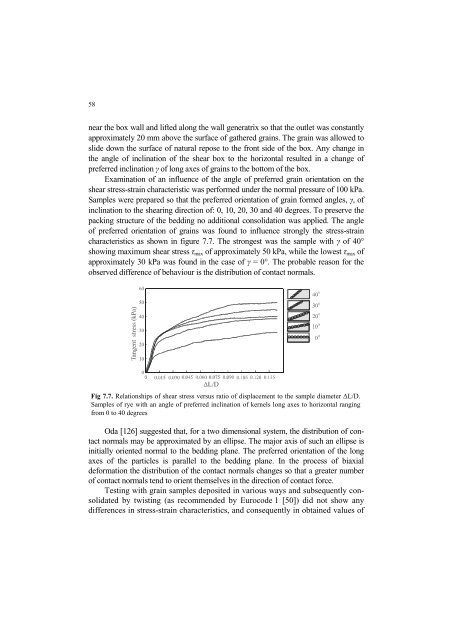Strona 2_redak - Instytut Agrofizyki im. Bohdana DobrzaÅskiego ...
Strona 2_redak - Instytut Agrofizyki im. Bohdana DobrzaÅskiego ...
Strona 2_redak - Instytut Agrofizyki im. Bohdana DobrzaÅskiego ...
Create successful ePaper yourself
Turn your PDF publications into a flip-book with our unique Google optimized e-Paper software.
58<br />
near the box wall and lifted along the wall generatrix so that the outlet was constantly<br />
approx<strong>im</strong>ately 20 mm above the surface of gathered grains. The grain was allowed to<br />
slide down the surface of natural repose to the front side of the box. Any change in<br />
the angle of inclination of the shear box to the horizontal resulted in a change of<br />
preferred inclination γ of long axes of grains to the bottom of the box.<br />
Examination of an influence of the angle of preferred grain orientation on the<br />
shear stress-strain characteristic was performed under the normal pressure of 100 kPa.<br />
Samples were prepared so that the preferred orientation of grain formed angles, γ, of<br />
inclination to the shearing direction of: 0, 10, 20, 30 and 40 degrees. To preserve the<br />
packing structure of the bedding no additional consolidation was applied. The angle<br />
of preferred orientation of grains was found to influence strongly the stress-strain<br />
characteristics as shown in figure 7.7. The strongest was the sample with γ of 40°<br />
showing max<strong>im</strong>um shear stress τ max of approx<strong>im</strong>ately 50 kPa, while the lowest τ max of<br />
approx<strong>im</strong>ately 30 kPa was found in the case of γ = 0°. The probable reason for the<br />
observed difference of behaviour is the distribution of contact normals.<br />
Fig 7.7. Relationships of shear stress versus ratio of displacement to the sample diameter ∆L/D.<br />
Samples of rye with an angle of preferred inclination of kernels long axes to horizontal ranging<br />
from 0 to 40 degrees<br />
Oda [126] suggested that, for a two d<strong>im</strong>ensional system, the distribution of contact<br />
normals may be approx<strong>im</strong>ated by an ellipse. The major axis of such an ellipse is<br />
initially oriented normal to the bedding plane. The preferred orientation of the long<br />
axes of the particles is parallel to the bedding plane. In the process of biaxial<br />
deformation the distribution of the contact normals changes so that a greater number<br />
of contact normals tend to orient themselves in the direction of contact force.<br />
Testing with grain samples deposited in various ways and subsequently consolidated<br />
by twisting (as recommended by Eurocode 1 [50]) did not show any<br />
differences in stress-strain characteristics, and consequently in obtained values of
















